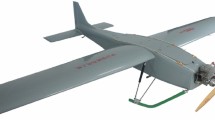Abstract
This paper presents an in-depth analytical and empirical assessment of the performance of DoubleBee, a novel hybrid aerial–ground robot. Particularly, the dynamic model of the robot with ground contact is analyzed, and the unknown parameters in the model are identified. We apply an unscented Kalman filter-based approach and a least square-based approach to estimate the parameters with given measurements and inputs at every time step. Real data are collected and used to estimate the parameters; test data verify that the values obtained are able to model the rotation of the robot accurately. A gain-scheduled feedback controller is proposed, which leverages the identified model to generate accurate control inputs to drive the system to the desired states. The system is proven to track a constant-velocity reference signal with bounded error. Simulations and real-world experiments using the proposed controller show improved performance than the PID-based controller in tracking step commands and maintaining attitude under robot movement.












Similar content being viewed by others
References
Tan, Y. H., & Chen, B. M. (2021). Survey on the development of aerial-aquatic hybrid vehicles. Unmanned Systems, 9(3), 263–282.
Kalantari, A., Touma, T., Kim, L., Jitosho, R., Strickland, K., Lopez, B. T., & Agha-Mohammadi, A.-A. (2020). Drivocopter: A concept hybrid aerial/ground vehicle for long-endurance mobility. In 2020 IEEE aerospace conference, pp. 1–10. Big Sky, MT, USA. https://doi.org/10.1109/AERO47225.2020.9172782.
Fang, X., Li, X., & Xie, L. (2020). Angle-displacement rigidity theory with application to distributed network localization. IEEE Transactions on Automatic Control, 66(6), 2574–2587.
Kalantari, A., & Spenko, M. (2014). Modeling and performance assessment of the hytaq, a hybrid terrestrial/aerial quadrotor. IEEE Transactions on Robotics, 30(5), 1278–1285. https://doi.org/10.1109/TRO.2014.2337555
Yang, J., Zhu, Y., Zhang, L., Dong, Y., & Ding, Y. (2022). Sytab: A class of smooth-transition hybrid terrestrial/aerial bicopters. IEEE Robotics and Automation Letters, 7(4), 9199–9206.
Zhang, D., Guo, C., Ren, H., Zhu, P., Xu, M., & Lu, H. (2021). The design of an aerial/ground dual-modal mobile robot for exploring complex environments. In 2021 IEEE international conference on real-time computing and robotics (RCAR), pp. 393–398. Xining, China. https://doi.org/10.1109/RCAR52367.2021.9517607.
Meiri, N., & Zarrouk, D. (2019). Flying star, a hybrid crawling and flying sprawl tuned robot. In 2019 international conference on robotics and automation (ICRA), pp. 5302–5308. Montreal, QC, Canada. https://doi.org/10.1109/ICRA.2019.8794260.
Sabet, S., Agha-Mohammadi, A.-A., Tagliabue, A., Elliott, D. S., & Nikravesh, P. E. (2019). Rollocopter: An energy-aware hybrid aerial-ground mobility for extreme terrains. In 2019 IEEE aerospace conference, pp. 1–8. Big Sky, MT, USA. https://doi.org/10.1109/AERO.2019.8741685.
Briod, A., Kornatowski, P., Zufferey, J.-C., & Floreano, D. (2014). A collision-resilient flying robot. Journal of Field Robotics, 31(4), 496–509.
Shin, W. D., Park, J., & Park, H.-W. (2018). Bio-inspired design of a gliding-walking multi-modal robot. In 2018 IEEE/RSJ international conference on intelligent robots and systems (IROS), pp. 8158–8164. Madrid, Spain. https://doi.org/10.1109/IROS.2018.8594210.
Kim, K., Spieler, P., Lupu, E.-S., Ramezani, A., & Chung, S.-J. (2021). A bipedal walking robot that can fly, slackline, and skateboard. Science Robotics, 6(59), 8136. https://doi.org/10.1126/scirobotics.abf8136
Cao, M., Xu, X., Yuan, S., Cao, K., Liu, K., & Xie, L. (2023). Doublebee: A hybrid aerial-ground robot with two active wheels. arXiv:2303.05075.
Wu, J., Wang, J., & You, Z. (2010). An overview of dynamic parameter identification of robots. Robotics and Computer-Integrated Manufacturing, 26(5), 414–419.
Cai, G., Chen, B. M., & Lee, T. H. (2011). Flight dynamics modeling (pp. 97–135). Springer. https://doi.org/10.1007/978-0-85729-635-1_6
Phang, S. K., Cai, C., Chen, B. M., & Lee, T. H. (2012). Design and mathematical modeling of a 4-standard-propeller (4sp) quadrotor. In Proceedings of the 10th world congress on intelligent control and automation, pp. 3270–3275. Beijing, China. https://doi.org/10.1109/WCICA.2012.6358437.
Zheng, M., Peng, P., Zhang, B., Zhang, N., Wang, L., & Chen, Y. (2015). A new physical parameter identification method for two-axis on-road vehicles: simulation and experiment. Shock and Vibration, 20, 15.
Kan, X., Thomas, J., Teng, H., Tanner, H. G., Kumar, V., & Karydis, K. (2019). Analysis of ground effect for small-scale uavs in forward flight. IEEE Robotics and Automation Letters, 4(4), 3860–3867.
Wan, E. A., & Van Der Merwe, R. (2000). The unscented Kalman filter for nonlinear estimation. In Proceedings of the IEEE 2000 adaptive systems for signal processing, communications, and control symposium (Cat. No.00EX373), pp. 153–158. Lake Louise, AB, Canada. https://doi.org/10.1109/ASSPCC.2000.882463.
Fang, X., Xie, L., & Li, X. (2023). Distributed localization in dynamic networks via complex laplacian. Automatica, 151, 110915.
Levenberg, K. (1944). A method for the solution of certain non-linear problems in least squares. Quarterly of Applied Mathematics, 2(2), 164–168.
Marquardt, D. W. (1963). An algorithm for least-squares estimation of nonlinear parameters. Journal of the Society for Industrial and Applied Mathematics, 11(2), 431–441.
ArduPilot Open-Source Flight Controller. https://ardupilot.org/. Accessed 13 May 2023.
Author information
Authors and Affiliations
Corresponding author
Rights and permissions
Springer Nature or its licensor (e.g. a society or other partner) holds exclusive rights to this article under a publishing agreement with the author(s) or other rightsholder(s); author self-archiving of the accepted manuscript version of this article is solely governed by the terms of such publishing agreement and applicable law.
About this article
Cite this article
Cao, M., Xu, X., Cao, K. et al. System identification and control of the ground operation mode of a hybrid aerial–ground robot. Control Theory Technol. 21, 458–468 (2023). https://doi.org/10.1007/s11768-023-00162-x
Received:
Revised:
Accepted:
Published:
Issue Date:
DOI: https://doi.org/10.1007/s11768-023-00162-x




